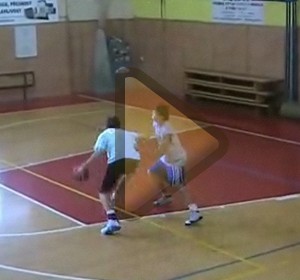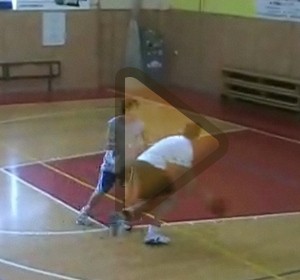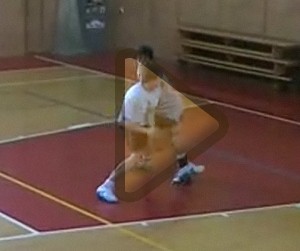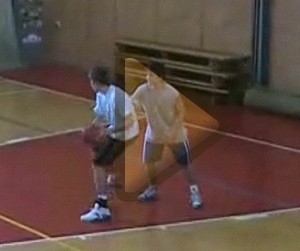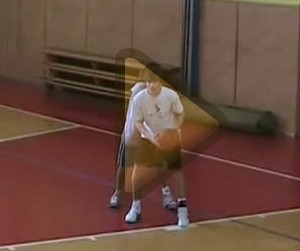Pivotman’s actions
after receiving ball in low-post
In terms of theory it is about getting open with ball off and on the move.
Pivot’s drive is an activity which aim is to get advantageous position for other actions with ball – for shot, dribbling or pass.
Getting open with ball on the move – dribbling
Training methodology:
Player in low-post always has to count with reinforcement of defence in his area and he has to react according to the defenders’ movements before he starts playing one-on-one. We consider important combinations with other players so centre can play one-on-one. As an example we can state pivot’s pass to weak side before his drive.
- Visual check of defender’s stance – look over the outside shoulder or under the legs.
- After ball receiving:
- re-pass fake, by which he occupy the defender of passer, player hold the ball in shoulder level, elbows apart (Fig. 23)
- look over the shoulder with fake movement to the base line, followed by drive in the middle and other way round
- In case of defender standing back the passer at the perimeter starts cutting to get position which is disadvantageous for returning defender (Fig. 24)
- After doubling and re-pass, centre continues with pushing his defender to the basket getting another pass (Lebo, 2005) (Fig. 25, 26)
- Pass to player cutting from perimeter or to shooting positions (Fig. 27, 28)
- Player estimates solution of action during his drive
- Drive in the paint is adjusted according to defender stance
- Followed by clearing by one bounce dribbling and shot after power lay-up
- When defence reinforcement pass to cutting teammate comes next
- Pivot man can use wait-and-see dribbling
Figures 29–34 show detailed foot-work of centres driving in the paint face and back to the basket (Paye, 1996).

Fig. 34: Spin back to beginning
Exercises focused on centre’s actions after receiving ball
Figures 35–36 show example of possible cooperation of players at position 4 and 5. Movement of the player without ball should enable the one-on-one situation for the player with ball in the paint.
Figures 37–39 show examples of movement of player without ball when reinforcement of defence on player with ball.
Critical parts:
- Wrong and instable stance
- Centre does not cover the ball
- Player does not use any fake moves
- Wrong choice of pivot foot – that is why it is profitable to did these actions after stop-jump, because player can choose from both legs. But stride stop also must not to be forgotten.
- Player needs to focus on proper dribbling, same as during other ball contacts hand is in touch with ball just by fingers and “calluses”. Movement comes from forehand and fluently passes to wrist. Ball is dribbled just in upper half and arm after bounce goes toward the ball and taking it gently. It is necessary to practise dribbling by both hands.
Faculty of Sports Studies of Masaryk University |
back to homepage, accessability |
| Service Center for E-Learning
| The Faculty of Informatics, Masaryk University, 2011
Technické řešení této výukové pomůcky je spolufinancováno Evropským sociálním fondem a státním rozpočtem České republiky.

